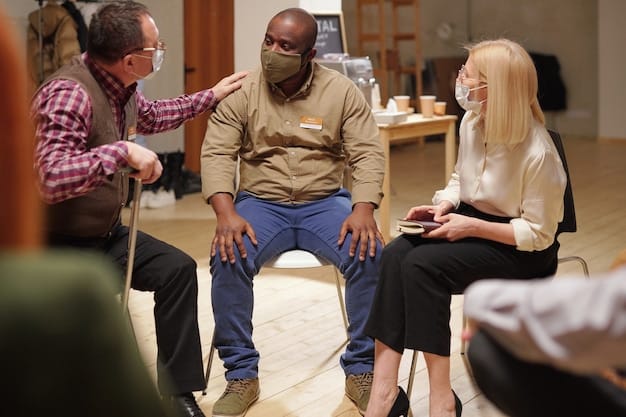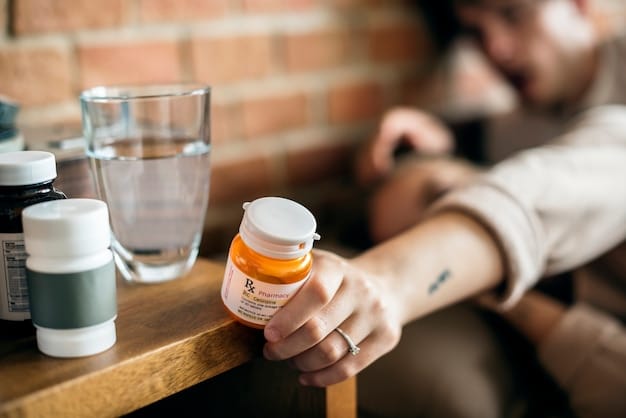Understanding New FDA-Approved Medications for Opioid Addiction Treatment

Opioid addiction treatment is evolving, with recent FDA approvals offering new hope; this article explores three of the newest medications, their mechanisms, and how they contribute to comprehensive recovery programs.
The landscape of opioid addiction treatment is constantly changing, and with it, new medications are emerging to help individuals on their journey to recovery. The FDA has recently approved several medications that offer unique approaches to managing opioid use disorder. Let’s delve into understanding these newest advancements.
Understanding Opioid Addiction Treatment
Opioid addiction is a complex condition that requires a multifaceted approach to treatment. Understanding the core of the addiction and how medications can assist is crucial for both individuals seeking recovery and healthcare professionals guiding them.
The Complexities of Opioid Addiction
Opioid addiction isn’t merely a physical dependence; it encompasses psychological and social factors. The brain’s reward system is hijacked, creating intense cravings and compulsive behavior. Effective treatment must address these interconnected elements.
The Role of Medication-Assisted Treatment (MAT)
Medication-Assisted Treatment (MAT) combines behavioral therapies with FDA-approved medications to provide a “whole-patient” approach to opioid addiction treatment. MAT has been proven to be clinically effective and can significantly improve patient survival.
- MAT reduces opioid cravings and withdrawal symptoms.
- It normalizes brain function, allowing the patient to focus on recovery.
- MAT helps to block the euphoric effects of opioids if relapse occurs.
MAT is an integral part of a comprehensive treatment plan, reducing the severity of withdrawal symptoms and decreasing the likelihood of relapse.

Lofexidine: A Non-Opioid Option for Managing Withdrawal
Lofexidine is a non-opioid medication that can significantly alleviate withdrawal symptoms for individuals discontinuing opioid use. By targeting the sympathetic nervous system, it provides a specific type of relief that can be critical during the initial phases of recovery.
How Lofexidine Works
Lofexidine works by reducing the release of norepinephrine, a neurotransmitter responsible for many withdrawal symptoms like anxiety, sweating, and rapid heartbeat. By calming down this overactivity, Lofexidine helps mitigate discomfort.
Benefits of Lofexidine
Unlike some other treatments, Lofexidine isn’t an opioid itself, eliminating the risk of dependence. It is an excellent option for individuals who prefer non-narcotic solutions for opioid withdrawal management.
Lofexidine helps manage withdrawal symptoms effectively, without introducing any dependence risk. It can be an excellent tool for patients during the detoxification process.
Naloxone Nasal Spray: Immediate Opioid Overdose Reversal
Naloxone nasal spray is an FDA-approved medication designed to rapidly reverse the effects of an opioid overdose. Easy to administer, it’s a critical tool for preventing fatalities and responding to crises in real-time.
The Urgency of Overdose Reversal
Opioid overdoses can depress breathing and heart rate, leading to brain damage or death in minutes. Naloxone acts quickly to restore normal respiratory function and awareness, buying crucial time until medical help arrives.
Administering Naloxone Nasal Spray
Naloxone nasal spray is designed for ease of use, even by people with no medical training. It’s sprayed into one nostril while the person is lying on their back, and its effects are generally seen within 2 to 3 minutes.
- Naloxone is safe and effective for reversing opioid overdoses.
- It can be administered by anyone, including family members and first responders.
- Naloxone’s effect is temporary, so it’s crucial to seek immediate medical attention.
Naloxone Nasal Spray plays a crucial role in overdose reversal, acting rapidly to restore breathing. Its accessibility can save lives, offering a critical intervention for emergency situations.

Buprenorphine/Naloxone Film: A Sublingual Treatment Option
Buprenorphine/Naloxone film is a prescription medication used sublingually to treat opioid use disorder (OUD). As a partial opioid agonist, buprenorphine helps to reduce cravings and withdrawal symptoms without producing the same intense high as other opioids.
Understanding Sublingual Administration
The Buprenorphine/Naloxone film is administered sublingually, allowing for rapid absorption into the bloodstream. This method of administration ensures that the medication is effectively delivered to the bloodstream, mitigating drug misuse.
The Benefits of Buprenorphine/Naloxone Film
The film formulation offers a convenient and discreet way to administer the medication, enhancing patient compliance and treatment efficacy.
- Reduces opioid cravings and withdrawal symptoms.
- Offers a discreet and convenient administration method.
- Helps patients maintain abstinence and continue recovery.
Buprenorphine/Naloxone film provides ease of use, supporting adherence to treatment plans and aiding in long-term recovery maintenance.
Holistic Treatment Approaches
While medications are vital, a well-rounded treatment plan for opioid addiction emphasizes holistic approaches. These encompass addressing psychological, social, and lifestyle factors to ensure a comprehensive recovery process.
The Importance of Behavioral Therapies
Cognitive Behavioral Therapy (CBT) and Dialectical Behavior Therapy (DBT) are crucial in helping individuals understand their triggers, develop coping mechanisms, and change negative thought patterns contributing to their addiction. These approaches empower individuals to take control of their recovery.
Integrating Support Systems
Family support, group therapy, and community resources enhance the treatment process. A robust support network reinforces positive behaviors and provides a sense of belonging during recovery.
Holistic treatment combines medical interventions with psychological and social support, leading to more sustained and meaningful recovery.
Navigating Treatment Options
Selecting the right treatment for opioid addiction involves understanding available options, consulting with healthcare professionals, and tailoring plans to meet individual needs. Empowerment through informed decisions is essential for successful recovery.
Consultation and Assessment
Begin with a comprehensive assessment by addiction specialists. This ensures a proper diagnosis and personalized treatment plan based on individual history, current health, and specific recovery goals.
Personalized Treatment Plans
No two individuals experience addiction the same way. Tailoring treatment plans to address specific needs, incorporating the most appropriate medications and therapies, is crucial for success.
Personalization is key to effective treatment, ensuring individuals receive the specific support and interventions they need for sustained recovery.
| Key Point | Brief Description |
|---|---|
| 💊 New Medications | FDA-approved medications provide diverse options for managing opioid addiction. |
| ⚕️ Lofexidine | A non-opioid option to alleviate withdrawal symptoms. |
| 🚑 Naloxone Nasal Spray | Reverses opioid overdoses quickly. |
| 🤝 Holistic Approaches | Include therapy, support systems, and personalized care. |
Frequently Asked Questions
▼
Medication-Assisted Treatment (MAT) combines behavioral therapies with medications, such as buprenorphine or naltrexone, to treat opioid use disorder. It’s an effective approach that addresses both physical and psychological aspects of addiction.
▼
Naloxone Nasal Spray reverses opioid overdoses by blocking the effects of opioids in the brain. It restores normal breathing and consciousness within minutes, but immediate medical attention is still crucial.
▼
No, Lofexidine is not an opioid. It is a non-opioid medication used to alleviate withdrawal symptoms by reducing the release of norepinephrine, a neurotransmitter involved in withdrawal symptoms.
▼
Buprenorphine/Naloxone film reduces cravings and withdrawal symptoms. The film formulation is discreet and convenient, encouraging better treatment compliance and aiding long-term recovery.
▼
A holistic approach addresses psychological, social, and lifestyle factors, ensuring a comprehensive recovery. This method includes behavioral therapies, support systems, and personalized care, leading to more sustained outcomes.
Conclusion
The evolving landscape of





